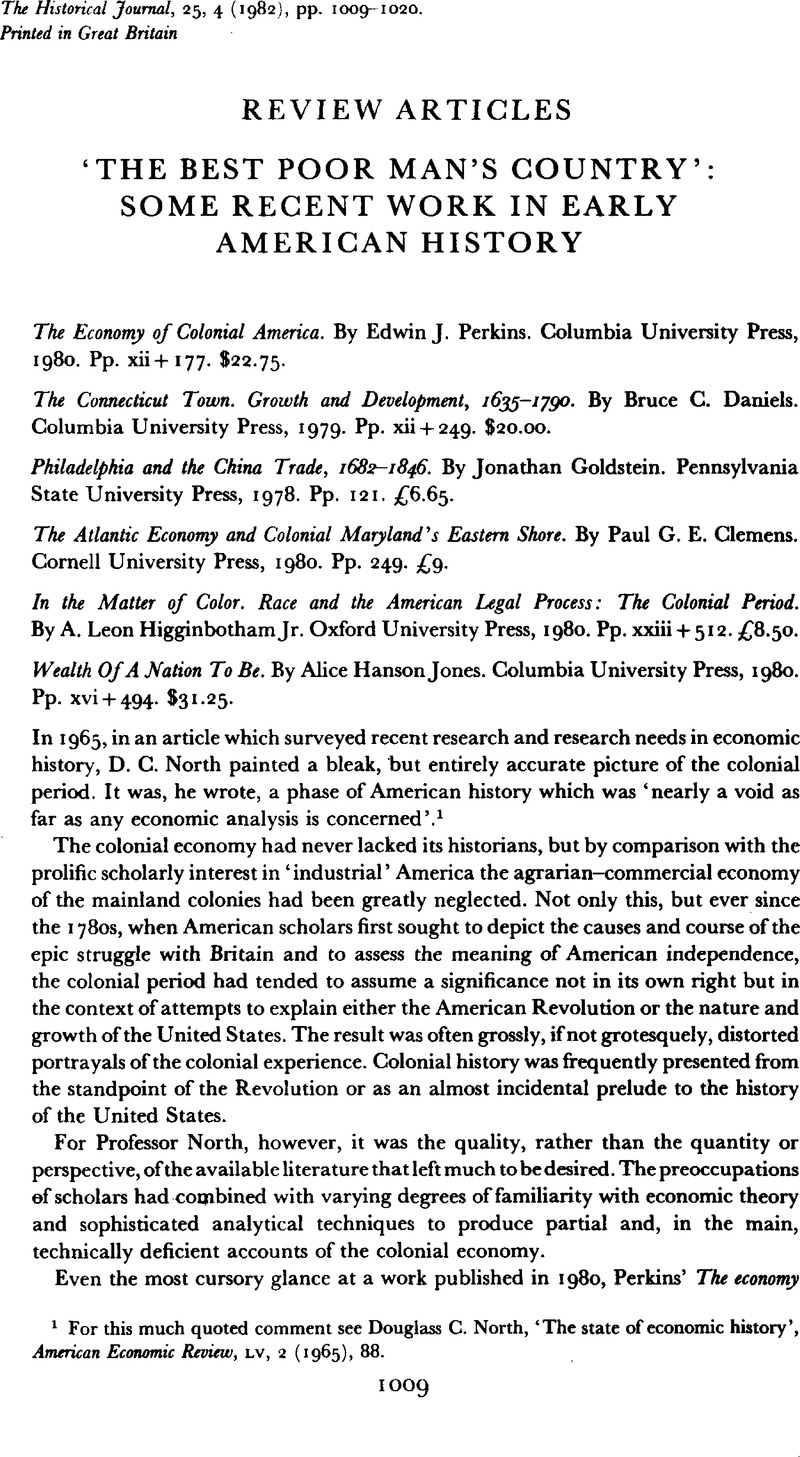No CrossRef data available.
Article contents
‘The Best Poor Man's Country’: Some Recent Work In Early American History
Published online by Cambridge University Press: 11 February 2009
Abstract

- Type
- Review Articles
- Information
- Copyright
- Copyright © Cambridge University Press 1982
References
1 For this much quoted comment see North, Douglass C., ‘The state of economic history’, American Economic Review, LV, 2 (1965), 88.Google Scholar
2 Potter, J., ‘The growth of population in America, 1700–1860’ in Glass, D. V. and Eversley, D. E. C. (eds.), Population in history (London and Chicago, 1965), 63188Google Scholar; Taylor, G. R., ‘American economic growth before 1840: an exploratory essay’, Journal of Economic History (December 1964), pp. 427–44Google Scholar; Main, J. T., The social structure of revolutionary America (Princeton, N.J. 1965).CrossRefGoogle Scholar
3 See for example, Greven, Philip, Four generations: population, land, and family in colonial Andover, Massachusetts (Ithaca, N.Y. 1970)Google Scholar; Lockridge, Kenneth, A New England town: the first hundred years: Dedham, Massachusetts (New York, 1970)Google Scholar and Demos, John, ‘Families in colonial Bristol, Rhode Island: an exercise in historical demography’, William and Mary Quarterly (January 1968), pp. 40–57.Google Scholar
4 See Zuckerman, Michael, Peacable kingdoms: New England towns in the eighteenth century (New York, 1970)Google Scholar, Bushman, Richard, From Puritan to Yankee: character and the social order in Connecticut, 1690–1765 (Cambridge, Mass. 1967)Google Scholar, Breen, T. H. and Foster, S., ‘The Puritans’ greatest achievement: a study of social cohesion in seventeenth-century Massachusetts’, Journal of American History (June 1973), pp. 5–22Google Scholar and, for one of the most influential studies, Brown, Robert, Middle-class democracy and the Revolution in Massachusetts, 1691–1780 (Ithaca, N.Y. 1955).Google Scholar
5 For criticisms of Taylor's estimate see David, Paul, ‘The growth of real product in the United States before 1840: new evidence and controlled conjectures’, Journal of Economic History (June 1967), pp. 151–97Google Scholar and Gallman, Robert, ‘The pace and pattern of Amercian economic growth’, in Lance, Davis (ed.), American economic growth (New York, 1972).Google Scholar
6 Walton, Gary and Shepherd, James, The economic rise of early America (London and New York, 1979). p. 131.Google Scholar
7 Nash, Gary B., The urban crucible: social change, political consciousness and the origins of the American Revolution (Cambridge, Mass. 1979).CrossRefGoogle Scholar
8 Ball, Duane and Walton, Gary, ‘Agricultural productivity change in eighteenth-century Pennsylvania’, Journal of Economic History (March 1976), pp. 102–17Google Scholar; Lemon, James, The best poor man's country: a geographical study of early Southeastern Pennsylvania (Baltimore, 1972).Google Scholar
9 David Klingaman, ‘The significance of grain in the development of the tobacco colonies’, Journal of Economic History (June 1969), pp. 268–78.
10 Perkins, , The economy of colonial America, pp. 47, 163Google Scholar; Egnal, Marc, ‘The economic development of the thirteen continental colonies’, William and Mary Quarterly (April 1975), pp. 191–222.Google Scholar
11 In addition to The economic rise of early America see their Shipping, maritime trade and the economic development of colonial North America (Cambridge University Press, 1972).Google Scholar
12 See Egnal's ‘The economic development of the thirteen continental colonies’, op. cit.
13 Gray, L. C., History of agriculture in the southern United States, 2 vols. (Washington, D.C. 1933).Google Scholar
14 See Breen, T. H. and Innes, S., ‘Myne owne ground’: race and freedom on Virginia's eastern shore, 1640–1676 (New York, 1980)Google Scholar; Menard, Russell, ‘From servants to slaves: the transformation of the Chesapeake labor system’, Southern Studies (Winter 1977), pp. 355–90Google Scholar; and Kulikoff, Allan, ‘The origins of Afro-American society in Tidewater Maryland and Virginia, 1700 to 1790’, William and Mary Quarterly (April 1978), pp. 226–59.Google Scholar
15 Ralph Gray and Betty Wood, ‘The transition from indentured to involuntary servitude in colonial Georgia’, Explorations in Economic History (1976), pp. 353–70.
16 William M. Wiecek, ‘The statutory law of slavery and race in the thirteen mainland colonies of British America’, William and Mary Quarterly (April 1977), pp. 258–80.
17 Henretta, James, The evolution of American society, 1700–1815 (Lexington, Mass. 1973). See also his ‘Economic development and social structure in colonial Boston’, William and Mary Quarterly (1965), pp. 75–92.Google Scholar
18 Warden, G. B., ‘The distribution of property in Boston, 1692–1775’, in Fleming, D. and Bailyn, B. (eds.), Perspectives in American history (Cambridge, Mass 1976), 10: 81–113.Google Scholar
19 Jeffrey Williamson and Peter Lindert, ‘Long term trends in American wealth inequality’ (paper cited by Perkins, The economy of colonial America, pp. 158, 165).




